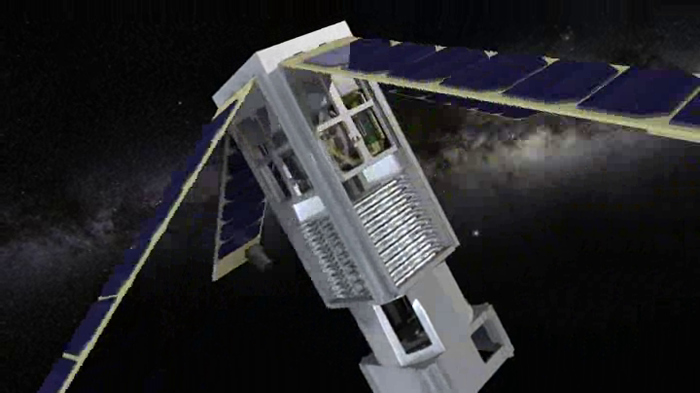Launching more than one satellite at a time is common practice these days, but what about packing thousands of satellites into a rocket and shooting them at the Moon? As part of a Kickstarter campaign, Pocket Spacecraft is offering the public the chance to send small disc satellites into space. These will then either flutter back to Earth from orbit or impact on the lunar surface. Based in Bristol, UK, Pocket Spacecraft plans to create thousands of tiny customized “Scout” satellites to be launched in a cubesat as a way of promoting low cost, mass space exploration.
Developed as an open source, open access project, the Scout is a disc 8 cm (3.2 in) in diameter and one-twentieth of a millimeter thick. It's made of polyimide, which is a polymer used for flexible electronic components, spacesuits, and solar sails. A nickel-titanium memory metal hoop holds it taut and acts as an antenna and it’s powered by commercial solar cells. The Scout supports components, sensors and instruments that are bonded to, or printed on, the polyimide, and the whole thing weighs well under a gram. When coated with a metallic film, it acts as a solar sail and Pocket Spacecraft claims that by being so light in relation to its area that, it can survive entering an atmosphere and flutter down.
The Scouts are to be launched in stacks of thousands inside the Interplanetary CubeSat Mothership. This five-kilogram (11 lb) spacecraft is based on a standard 3U cubesat and is designed to piggyback on commercial satellite launches. Once in orbit, it gets to its destination using either a solar sail or an electrolysis propulsion system that uses solar power to split water into hydrogen and oxygen, which can then be burned as propellant. Once the Mothership releases and photographs the satellites, it acts as a relay for satellite telemetry.

The idea behind the Kickstarter campaign is for the public to not only fund launching satellites, but to customize satellites in ways that range from having images or messages printed on them to customizing the hardware and software. Three quarters of the satellite surface can be customized with either single or multiple images, as well as by adding such components as a single pixel optical sensor, accelerometer, gyroscope, temperature sensor, and strain gauges. The backers use a web browser to indicate the modifications, which Pocket Spacecraft executes.
The Scout uses a standard Arduino development environment, and Pocket Spacecraft is developing a web-based integrated development environment for writing and testing code, and to test a modified pocket spacecraft in a virtual environment. Backers are also provided with a Pocket Mission Control app that allows them to follow the Mothership’s launch, and see their satellite’s telemetry, which is relayed by the Mothership or a ground station to the user’s smartphone. Using an augmented reality feature, they can hold up their smartphone and see where their spacecraft is in the sky.
Pledges starting at £99 (US$150) allow backers to send a Scout into Earth orbit, where it will re-enter the atmosphere, and for £199 ($300) the satellite goes to the Moon. The developers say they need at least 2,000 satellites backed for a launch, but would prefer over 8,000.

If sufficient backing can be found, the design of the Scout craft will be tested and then launched with a commercial satellite on a trajectory suitable for reaching, as a first target, the Moon. Some satellites, called Earth Scouts, will be released to test their ability to re-enter the atmosphere, and to see if they can be tracked and recovered. The rest, called Lunar Scouts, will be carried by the Mothership as it uses the propulsion system to put it into a Weak Stability Boundary (WSB) low-energy transfer orbit to slingshot the craft from a Geostationary Transfer Orbit (GTO) to the Moon in a voyage that will take months.
While in space, the Mothership will be tracked with two refurbished ground stations, and amateur radio enthusiasts will also help with tracking and data relay. Commercial, university and government tracking resources may also be used. Once in lunar orbit, the Lunar Scouts will be released to fall on the Moon surface in a high-speed impact.
“By backing this mission, people will revolutionize space exploration and space science,” says Michael Johnson, founder of Pocket Spacecraft. “By democratizing interplanetary space exploration we will create a generation of young explorers who can use the same affordable methods to explore Mars, Venus and beyond. We’re building tools so that one day every child will be able to send their own spacecraft on a robotic field trip in space”.
The Kickstarter campaign ends on August 26.
Sources: Pocket Spacecraft, Kickstarter












